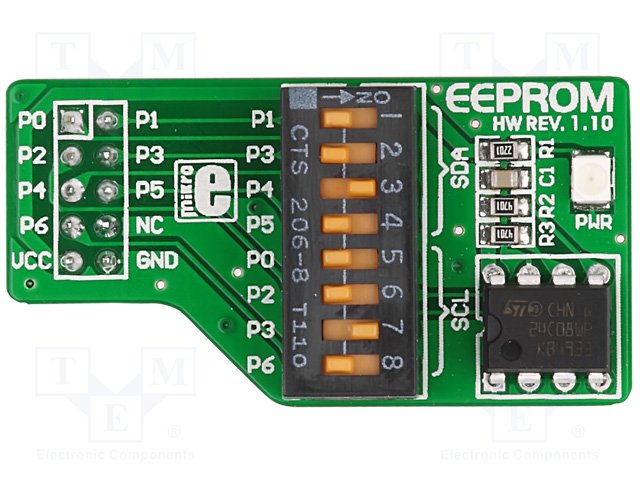
EEPROM,或写作E2PROM,全称电可擦除可编程只读存储器 (英语:Electrically-Erasable Programmable Read-Only Memory),是一种可以通过电子方式多次复写的半导体存储设备。相比EPROM,EEPROM不需要用紫外线照射,也不需取下,就可以用特定的电压,来抹除芯片上的信息,以便写入新的数据。
EEPROM有四种工作模式:读取模式、写入模式、擦除模式、校验模式。读取时,芯片只需要Vcc低电压(一般+5V)供电。编程写入时, 芯片通过Vpp(一般+25V, 较新者可能使用 12V 或 5V)获得编程电压,并通过PGM编程脉冲(一般50ms)写入数据。擦除时,只需使用Vpp高电压,不需要紫外线,便可以擦除指定地址的内容。为保证写 入正确,在每写入一块数据后,都需要进行类似于读取的校验步骤,若错误就重新写入。现今的 EEPROM 通常已不再需要使用额外的 Vpp 电压,且写入时间也已有缩短。
由于EEPROM的优秀性能,以及在线上操作的便利,它被广泛用于需要经常擦除的BIOS芯片以及闪存芯片,并逐步替代部分有断电保留需要的RAM芯片,甚至取代部分的硬盘功能(见固态硬盘)。它与高速RAM成为当前(21世纪00年代)最常用且发展最快的两种存储技术。
Ein EEPROM (engl. Abk. für electrically erasable programmable read-only memory, wörtlich: elektrisch löschbarer programmierbarer Nur-Lese-Speicher, auch E2PROM) ist ein nichtflüchtiger, elektronischer Speicherbaustein, dessen gespeicherte Information elektrisch gelöscht werden kann. Er ist verwandt mit anderen löschbaren Speichern, wie dem durch UV-Licht löschbaren EPROMs und dem ebenfalls elektrisch löschbaren Flash-Speicher. Er wird verwendet zur Speicherung kleinerer Datenmengen in elektrischen Geräten, bei denen die Information auch ohne anliegende Versorgungsspannung erhalten bleiben muss oder bei denen einzelne Speicherelemente bzw. Datenworte einfach zu ändern sein müssen. Ein typisches Beispiel ist der Rufnummernspeicher eines Telefons. Zur Speicherung größerer Datenmengen wie z. B. dem BIOS in PC-Systemen sind meist Flash-Speicher ökonomischer.
EEPROM (also E2PROM) stands for Electrically Erasable Programmable Read-Only Memory and is a type of non-volatile memory used in computers, integrated in microcontrollers for smart cards and remote keyless system, and other electronic devices to store relatively small amounts of data but allowing individual bytes to be erased and reprogrammed.
EEPROMs are organized as arrays of floating-gate transistors. EEPROMs can be programmed and erased in-circuit, by applying special programming signals. Originally, EEPROMs were limited to single byte operations which made them slower, but modern EEPROMs allow multi-byte page operations. It also has a limited life for erasing and reprogramming, now reaching a million operations in modern EEPROMs. In an EEPROM that is frequently reprogrammed while the computer is in use, the life of the EEPROM is an important design consideration.
Flash memory is a type of EEPROM designed for high speed and high density, at the expense of large erase blocks (typically 512 bytes or larger) and limited number of write cycles (often 10,000). There is no clear boundary dividing the two, but the term "EEPROM" is generally used to describe non-volatile memory with small erase blocks (as small as one byte) and a long lifetime (typically 1,000,000 cycles). Many microcontrollers include both: flash memory for the firmware, and a small EEPROM for parameters and history.
La mémoire EEPROM (Electrically-Erasable Programmable Read-Only Memory ou mémoire morte effaçable électriquement et programmable) (aussi appelée E2PROM ou E²PROM) est un type de mémoire morte. Une mémoire morte est une mémoire utilisée pour enregistrer des informations qui ne doivent pas être perdues lorsque l'appareil qui les contient n'est plus alimenté en électricité.
EEPROM (anche scritto E2PROM), acronimo di Electrically Erasable Programmable Read-Only Memory, è un tipo di memoria non volatile, usata nei computer e altri dispositivi elettronici per memorizzare piccole quantità di dati che devono essere mantenuti quando viene tolta l'alimentazione elettrica (per esempio la configurazione del dispositivo). Le operazioni di scrittura, cancellazione e riscrittura hanno luogo elettricamente.
Ciascuna cella di memoria capace di memorizzare un singolo bit è costituita da due transistori MOS, uno "di memoria" e uno "di accesso".
EEPROM o E²PROM son las siglas de Electrically Erasable Programmable Read-Only Memory (ROM programable y borrable eléctricamente). Es un tipo de memoria ROM que puede ser programada, borrada y reprogramada eléctricamente, a diferencia de la EPROM que ha de borrarse mediante un aparato que emite rayos ultravioleta. Son memorias no volátiles.
Las celdas de memoria de una EEPROM están constituidas por un transistor MOS, que tiene una compuerta flotante (estructura SAMOS), su estado normal está cortado y la salida proporciona un 1 lógico.
Aunque una EEPROM puede ser leída un número ilimitado de veces, sólo puede ser borrada y reprogramada entre 100.000 y un millón de veces.
Estos dispositivos suelen comunicarse mediante protocolos como I²C, SPI y Microwire. En otras ocasiones, se integra dentro de chips como microcontroladores y DSPs para lograr una mayor rapidez.
La memoria flash es una forma avanzada de EEPROM creada por el Dr. Fujio Masuoka mientras trabajaba para Toshiba en 1984 y fue presentada en la Reunión de Aparatos Electrónicos de el IEEE de 1984. Intel vio el potencial de la invención y en 1988 lanzó el primer chip comercial de tipo NOR.







